1940s
Mystery Illustration 37

What horrors are causing the eyes of this Bride-of-Frankenstein lookalike to bug out?
Answer after the jump.
More in extended >>
Posted By: Paul - Sun Jan 22, 2017 -
Comments (4)
Category: Horror, Advertising, 1940s, Eyes and Vision, Face and Facial Expressions
Non-Terrifying Gas Mask
1941: Charles Leguillon, a manager at the B.F. Goodrich Co., invented a "non-terrifying gas mask" that a pretty girl could wear "and remain a pretty girl and not become a gargoyle."The media proclaimed that for this he deserved "female thanks," because of course all women want to continue looking their best, even during chemical warfare.
But was the new gas mask actually non-terrifying? I'll let you be the judge.
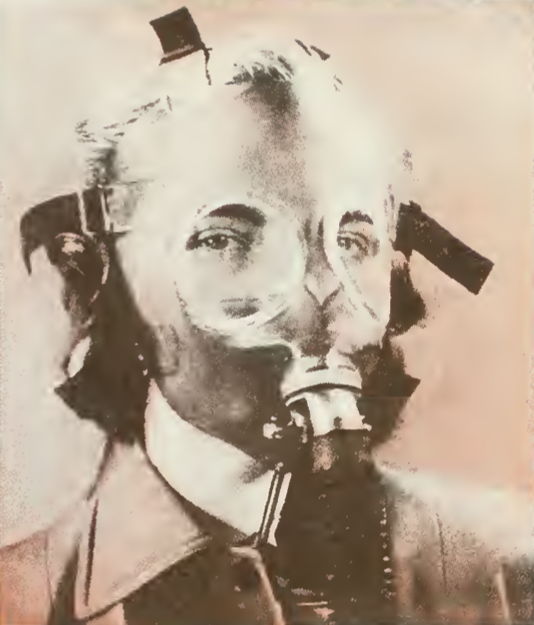
American Legion Magazine - Aug 1941

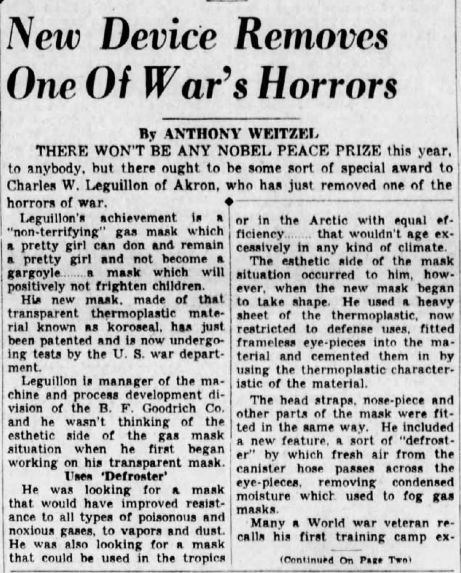
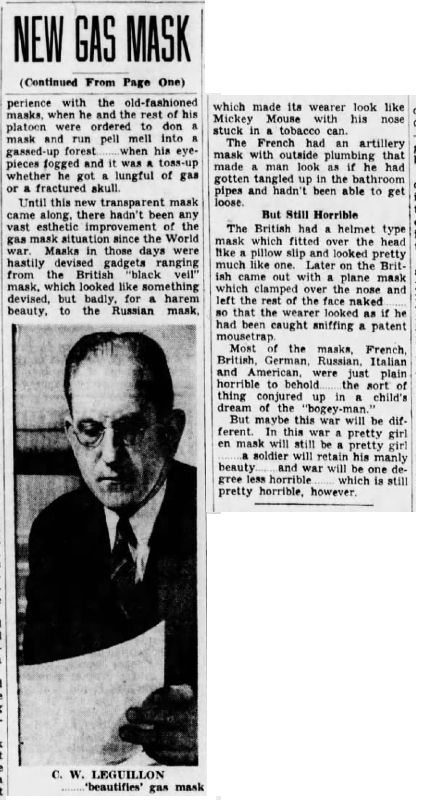
The Akron Beacon Journal - June 11, 1941
Posted By: Alex - Mon Jan 09, 2017 -
Comments (2)
Category: Costumes and Masks, Military, 1940s
Irv Pollock, Auto Dealer

According to this verbal portrait of the era,, the Toledo, Ohio, car-dealership scene of the 40s, 50s and 60s was a vibrant, competitive time. Certainly a dealer would want to come up with wild ads to stand out. Irv Pollock must have felt that way anyhow!
Note: you might have to scroll left or right at the links to see the original ad.
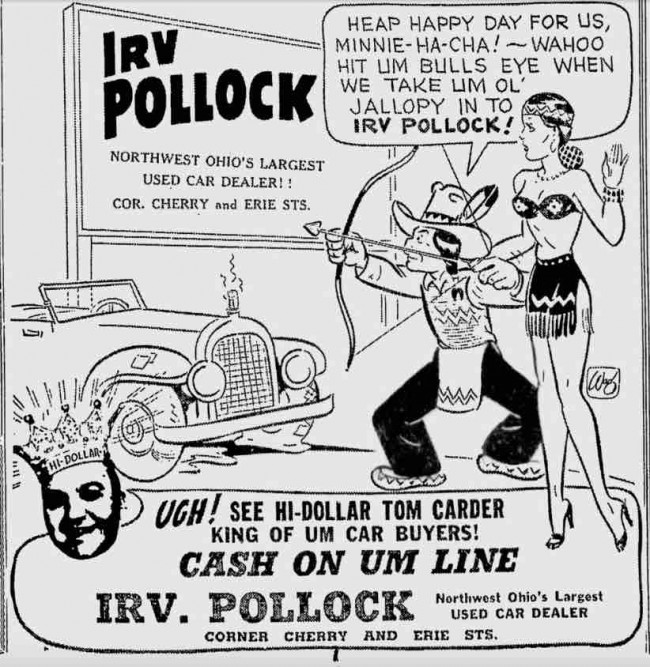
Original ad here.
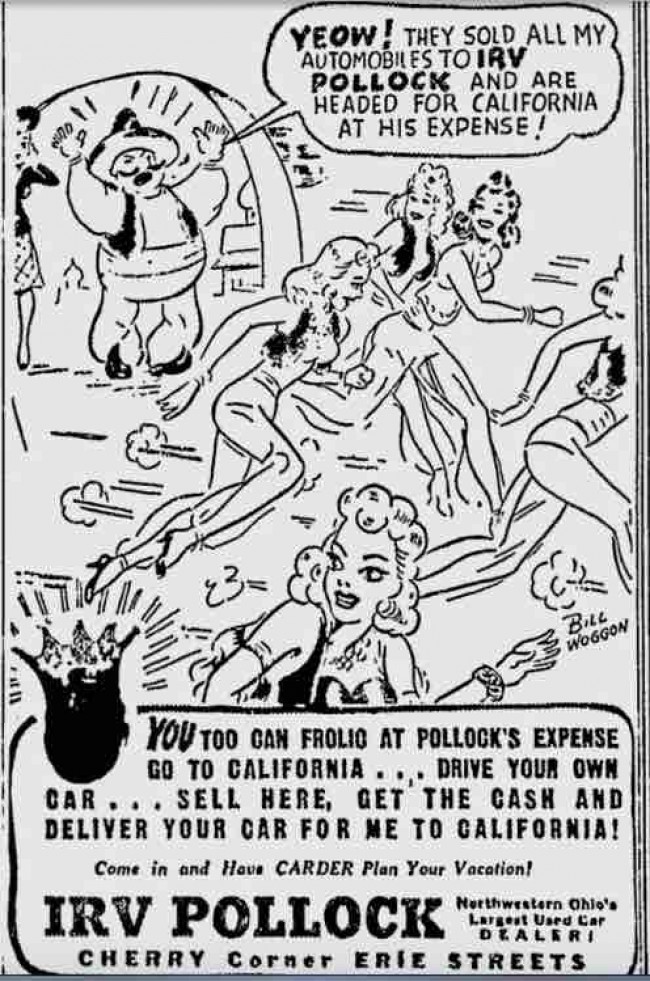
Original ad here.
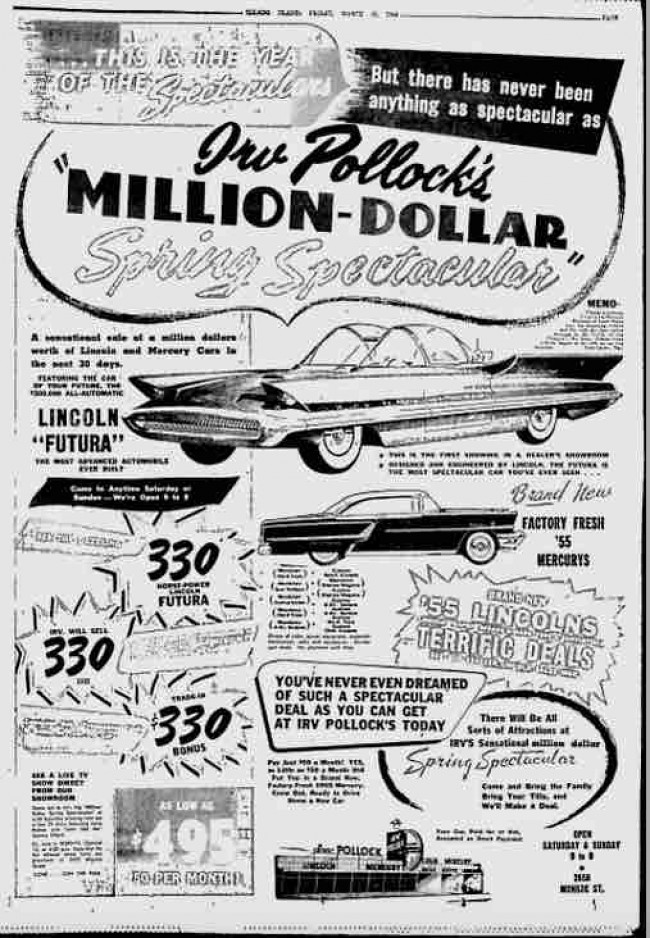
Original ad here.
Posted By: Paul - Sat Jan 07, 2017 -
Comments (3)
Category: Business, Advertising, Excess, Overkill, Hyperbole and Too Much Is Not Enough, Regionalism, 1940s, 1950s, Cars
Mousetrap Cigarette Lighter
Introduced at the 1941 meeting of the Inventors of America society in New York — a combined mousetrap and cigarette lighter.The caption on the first image is confusing. It says "a lever sets the mouse in motion," but I assume that's a mistake. It should probably read, "The mouse sets a lever in motion."
Another newspaper offered the following explanation of the device's operation: "When mouse springs trap, it sends pinball down ramp. Ball releases spring, and up pops an arm which strikes a match."
When the Inventors of America met again later that year in Los Angeles, one of their members showed off some mice-killing

The San Bernardino County Sun - July 25, 1941

The Pittsburgh Press - July 27, 1941
Posted By: Alex - Fri Jan 06, 2017 -
Comments (4)
Category: Inventions, 1940s
The Case of the X-Ray Camera
New Year's Eve, 1946 was the occasion of a classic weird crime.19-year-old Pearl Lusk thought she had been employed to do some detective work by Allen La Rue, whom she had met on the subway. He told her that he was an insurance investigator. Her mission was to track a suspected jewel thief, Olga Trapani, and collect evidence to build a case against her.
Lusk trailed Trapani for a few days, and then La Rue added a new twist to the assignment. He gave her what he described as an "X-ray camera" camouflaged as a gift-wrapped package and instructed her to take a picture of Trapani with it. The resulting photo, he said, would reveal the jewels that Trapani kept pinned inside her dress, around her waist.
Lusk dutifully followed Trapani into the Times Square subway station, pointed the camera at her, and pulled the trigger wire. A shot rang out and Trapani collapsed to the ground.
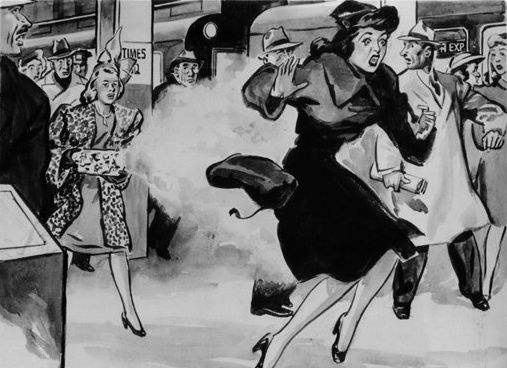
It turned out that the "X-ray camera" was really a camouflaged sawed-off shotgun. And Trapani was really La Rue's ex-wife, of whom he had grown insanely jealous. La Rue's real name was Alphonse Rocco. He had been stalking his ex-wife for several months.
Lusk was totally clueless about what she had done. As the subway police rushed up after the shooting, she told them, "I just took this woman’s picture and somebody shot her."
Rocco fled to upstate New York, where he died in a shootout with the police several days later.
Trapani survived, but lost her leg. She and Lusk reportedly became friends after the incident.
You can read more about the case at EinsteinsRefrigerator.com, or the New Yorker.
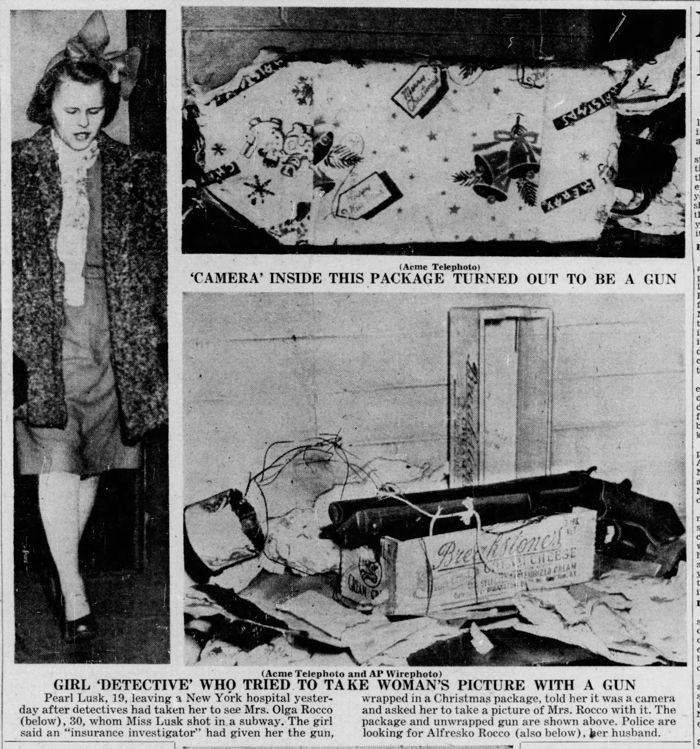
Philadelphia Inquirer - Jan 1, 1947
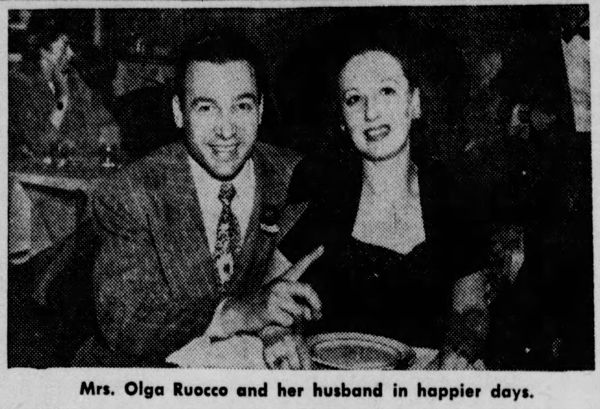
Washington Court House Record-Herald - Jan 3, 1947
Posted By: Alex - Sat Dec 31, 2016 -
Comments (1)
Category: Crime, 1940s
Mystery Illustration 35

Which famous film star is this drawing intended to represent?
Answer after the jump.
More in extended >>
Posted By: Paul - Mon Dec 26, 2016 -
Comments (3)
Category: Celebrities, Movies, 1940s
Hurff Canned Goods
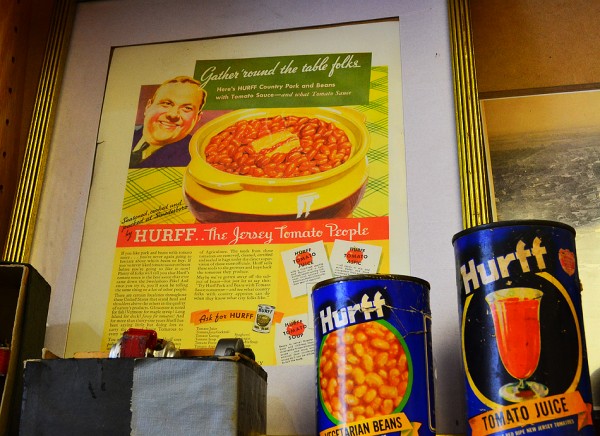
Once upon a time, a company with the somewhat off-putting name of Hurff was big enough to advertise in a top-of-the-line national magazine like LIFE.
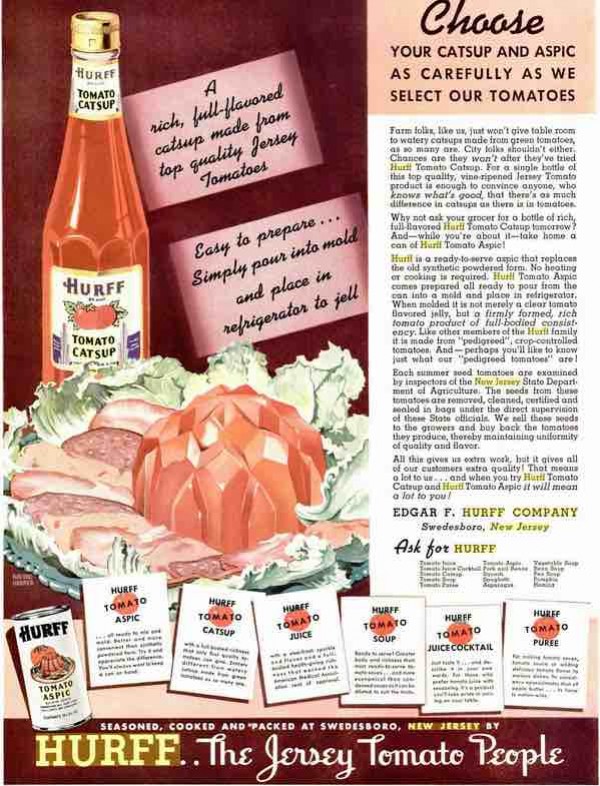
Here's the backstory, so far as I can find out.
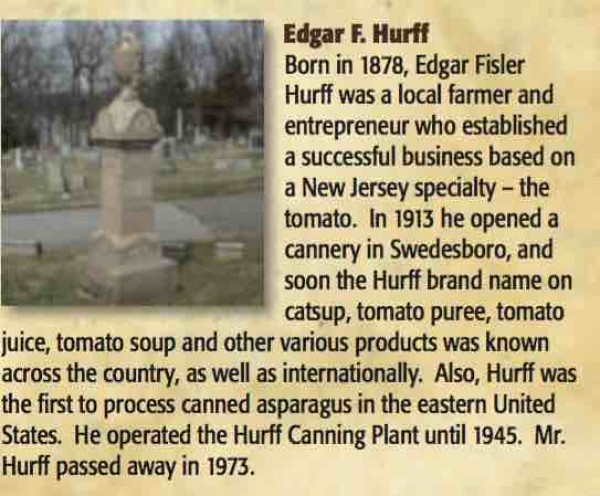
I have found ads from them as late as 1948. Does that mean that store was selling three-year-old cans of food, given the plant-closing date of 1945? Or maybe the plant did not close, but Hurff himself was forced out? We will probably never know...

Hurff is a fine forgotten piece of what cartoonist Robert Crumb calls "weird old America."
Posted By: Paul - Fri Dec 16, 2016 -
Comments (10)
Category: Food, Regionalism, Advertising, 1930s, 1940s
Fish Chokes Swimmer
One for the weird death file: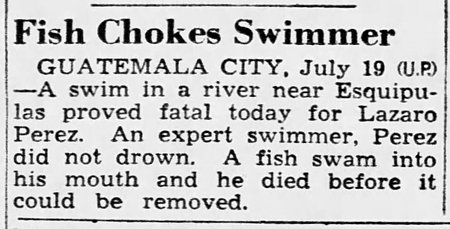
Great Falls Tribune - July 20, 1945
GUATEMALA CITY, July 19 (U.P.) — A swim in a river near Esquipulas proved fatal today for Lazaro Perez. An expert swimmer, Perez did not drown. A fish swam into his mouth and he died before it could be removed.
Posted By: Alex - Wed Dec 14, 2016 -
Comments (1)
Category: Death, Fish, 1940s
Just Imagine
The uproarious laughter by the human executive at the antics of Tommy Telephone, a plainly impossible vision, proclaims that the fellow is gratefully descending into the dark swamp of insanity due to the high stresses of his job.
Posted By: Paul - Sat Dec 10, 2016 -
Comments (2)
Category: Business, Advertising, Corporate Mascots, Icons and Spokesbeings, Products, Communications, Delusions, Fantasies and Other Tricks of the Imagination, Technology, Telephones, Cartoons, Stop-motion Animation, 1940s, Brain Damage
Vile and Filthy Morse Code
January 1945: Residents of Halifax complained to the police that people were driving around at night and using their horns to signal "vile and filthy language" in morse code.So it wasn't the honking, per se, that bothered the residents, but what the honks meant. Guess it was a different time, when a significant number of people actually understood morse.
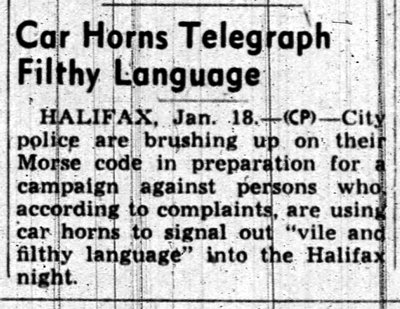
Ottawa Journal - Jan 18, 1945
Posted By: Alex - Fri Dec 09, 2016 -
Comments (6)
Category: Languages, 1940s

| Who We Are |
|---|
| Alex Boese Alex is the creator and curator of the Museum of Hoaxes. He's also the author of various weird, non-fiction, science-themed books such as Elephants on Acid and Psychedelic Apes. Paul Di Filippo Paul has been paid to put weird ideas into fictional form for over thirty years, in his career as a noted science fiction writer. He has recently begun blogging on many curious topics with three fellow writers at The Inferior 4+1. Contact Us |




